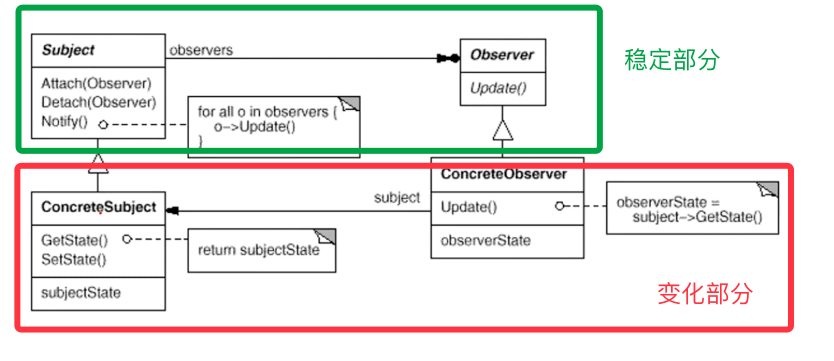设计动机
- 在软件构建过程中,我们需要为某些对象建立一种 "通知依赖关系”:一个对象(目标对象)的状态发生改变,所有的依赖对象(观察者对象)都将得到通知。如果这样的依赖关系过于紧密将使软件不能很好地抵御变化
- 使用面向对象技术,可以将这种依赖关系弱化,并形成一种稳定的依赖关系。从而实现软件体系结构的松耦合
定义
定义对象间的一种一对多(变化)的依赖关系,以便当一个对象(Subject)的状态发生改变时,所有依赖于它的对象都得到通知并自动更新
结构

例子
传统通知模式
1
2
3
4
5
6
7
8
9
10
11
12
13
14
15
16
17
18
19
20
21
22
23
24
25
26
27
28
29
30
31
|
class FileSplitter
{
string m_filePath;
int m_fileNumber;
ProgressBar* m_progressBar;
public:
FileSplitter(const string& filePath, int fileNumber, ProgressBar* progressBar) :
m_filePath(filePath),
m_fileNumber(fileNumber),
m_progressBar(progressBar){
}
void split(){
for (int i = 0; i < m_fileNumber; i++){
float progressValue = m_fileNumber;
progressValue = (i + 1) / progressValue;
m_progressBar->setValue(progressValue);
}
}
};
|
1
2
3
4
5
6
7
8
9
10
11
12
13
14
15
16
17
18
19
20
|
class MainForm : public Form
{
TextBox* txtFilePath;
TextBox* txtFileNumber;
ProgressBar* progressBar;
public:
void Button1_Click(){
string filePath = txtFilePath->getText();
int number = atoi(txtFileNumber->getText().c_str());
FileSplitter splitter(filePath, number, progressBar);
splitter.split();
}
};
|
观察者模式
1
2
3
4
5
6
7
8
9
10
11
12
13
14
15
16
17
18
19
20
21
22
23
24
25
26
27
28
29
30
31
32
33
34
35
36
37
38
39
40
41
42
43
44
45
46
47
48
49
50
51
52
53
54
55
56
57
58
59
60
61
|
class IProgress{
public:
virtual void DoProgress(float value)=0;
virtual ~IProgress(){}
};
class FileSplitter
{
string m_filePath;
int m_fileNumber;
List<IProgress*> m_iprogressList;
public:
FileSplitter(const string& filePath, int fileNumber) :
m_filePath(filePath),
m_fileNumber(fileNumber){
}
void split(){
for (int i = 0; i < m_fileNumber; i++){
float progressValue = m_fileNumber;
progressValue = (i + 1) / progressValue;
onProgress(progressValue);
}
}
void addIProgress(IProgress* iprogress){
m_iprogressList.push_back(iprogress);
}
void removeIProgress(IProgress* iprogress){
m_iprogressList.remove(iprogress);
}
protected:
virtual void onProgress(float value){
List<IProgress*>::iterator itor=m_iprogressList.begin();
while (itor != m_iprogressList.end() )
(*itor)->DoProgress(value);
itor++;
}
}
};
|
1
2
3
4
5
6
7
8
9
10
11
12
13
14
15
16
17
18
19
20
21
22
23
24
25
26
27
28
29
30
31
32
33
34
35
36
37
38
39
40
|
class MainForm : public Form, public IProgress
{
TextBox* txtFilePath;
TextBox* txtFileNumber;
ProgressBar* progressBar;
public:
void Button1_Click(){
string filePath = txtFilePath->getText();
int number = atoi(txtFileNumber->getText().c_str());
ConsoleNotifier cn;
FileSplitter splitter(filePath, number);
splitter.addIProgress(this);
splitter.addIProgress(&cn);
splitter.split();
splitter.removeIProgress(this);
}
virtual void DoProgress(float value){
progressBar->setValue(value);
}
};
class ConsoleNotifier : public IProgress {
public:
virtual void DoProgress(float value){
cout << ".";
}
};
|
总结
- 使用面向对象的抽象, Observer模式使得我们可以独立地改变目标与观察者,从而使二者之间的依赖关系达致松耦合
- 目标发送通知时,无需指定观察者,通知(可以携带通知信息作为参数)会自动传播
- 观察者自己决定是否需要订阅通知,目标对象对此一无所知
- Observer模式是基于事件的UI框架中非常常用的设计模式,也是MVC模式的一个重要组成部分



